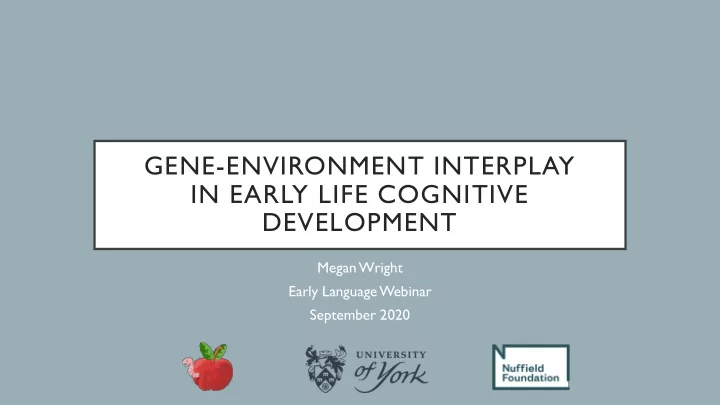

GENE-ENVIRONMENT INTERPLAY IN EARLY LIFE COGNITIVE DEVELOPMENT Megan Wright Early Language Webinar September 2020
GENETIC INFLUENCE ON LANGUAGE DEVELOPMENT • 13-17% heritability of expressive vocabulary • Identified genes may help infants to develop language and produce sounds • linked with autism, dyslexia, speech-sound disorders, and the development of reading St Pourcain, B., et al. (2014). Common variation near ROBO2 is associated with expressive vocabulary in infancy. Nature Communications , 5:4831.
ENVIRONMENTAL INFLUENCES ON LANGUAGE DEVELOPMENT • Socio-economic status • Differences between children from low and high SES as early as 2 years of age • Children from low SES families score on average 6 IQ points lower than children from high SES backgrounds • Maternal speech • Quality and quantity of language is important • Mediates the relationship between SES and children’s vocabulary development von Stumm, S., & Plomin, R. (2015). Socioeconomic status and the growth of intelligence from infancy through adolescence. Intelligence, 48, 30-36. Hoff, E. (2003). The specificity of environmental influence: Socioeconomic status affects early vocabulary development via maternal speech. Child development , 74 (5), 1368-1378.
OUR STUDY Gene-environment interplay in early life cognitive development
THE HUNGRY MIND LAB TEAM Professor Sophie von Stumm Dr. Allie Nancarrow Megan Wright Head of the Hungry Mind Lab Postdoctoral Researcher Research Project Coordinator
GENE-ENVIRONMENT INTERPLAY • Gene-environment interplay = how genetic and environmental factors interact to influence complex traits X
GENETIC FACTORS: GENOME-WIDE POLYGENIC SCORES • Use large sample sizes • Identify tiny DNA variants associated with a certain trait
ENVIRONMENTAL FACTORS Home environment Number of siblings • • Number of books • CHAOS scale • Breastfeeding Neighbourhood • Nursery environment • Proximity to green spaces • Crime rate Pollution • • Income decile Traffic density •
POTENTIAL IMPACT OF OUR RESEARCH • Cognitive development and early language skills have important influences on educational success and later life outcomes • Early identification of children who would benefit from intervention • Personalized interventions
SUMMARY • Early language development is influenced by both genetic and environmental factors • Understanding the gene-environment interplay in children’s early cognitive development is crucial for identification and personalization of interventions.
www.hungrymindlab.com/gene-environment-interplay THANK YOU! @HungryMindLab m.wright@york.ac.uk
Recommend
More recommend